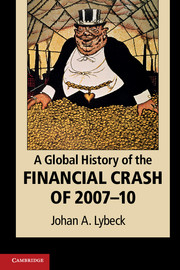Book contents
- Frontmatter
- Contents
- List of figures
- List of tables
- Preface
- Acknowledgments
- Abbreviations
- 1 Introduction
- 2 Financial crises in the USA and Europe, but not in Asia
- 3 Could today’s financial crisis have been foreseen?
- 4 The US housing market and the subprime crisis
- 5 Securitization and derivatives spread the crisis around the world
- 6 Liquidity risk aspects of the crisis and a comparison with 1907 and 1929
- 7 Credit risk aspects of the crisis, rating and solvency
- 8 Financial crises in modern history
- 9 Worldwide changes in regulation and supervision as a result of the crisis
- 10 Outstanding issues
- Bibliography
- Index
- References
4 - The US housing market and the subprime crisis
Published online by Cambridge University Press: 05 June 2012
- Frontmatter
- Contents
- List of figures
- List of tables
- Preface
- Acknowledgments
- Abbreviations
- 1 Introduction
- 2 Financial crises in the USA and Europe, but not in Asia
- 3 Could today’s financial crisis have been foreseen?
- 4 The US housing market and the subprime crisis
- 5 Securitization and derivatives spread the crisis around the world
- 6 Liquidity risk aspects of the crisis and a comparison with 1907 and 1929
- 7 Credit risk aspects of the crisis, rating and solvency
- 8 Financial crises in modern history
- 9 Worldwide changes in regulation and supervision as a result of the crisis
- 10 Outstanding issues
- Bibliography
- Index
- References
Summary
Speculation and bubbles are eternal, only the object varies
A bubble will always follow its own rhythm, fundamentally unchanged in character throughout the centuries, from speculation in tulip buds in Holland in the seventeenth century, to today’s speculation in US, British, Irish and Spanish house prices. The first phase is usually engineered by an exogenous event which enables speculation in higher future prices. Financial bubbles have most often followed deregulations, which create new possibilities but also new risks, of which the financial actors have not always been aware. The thrift crisis in the USA in the 1980s, the Japanese, Asian and Nordic crises of the 1990s, and today’s crisis all bear traits of this type. We will return to their history in . Many want to see the changed legislation of 1999, which repealed the separation between commercial banking, investment banking and insurance (the Glass-Steagall Act of 1933), as one of the main drivers behind the subprime crisis.
As pointed out earlier, the move from organized and regulated credit markets in banks and investment banks to the “shadow banking system,” with the ensuing loss of supervision, may also be characterized as an act of deregulation, albeit unintended. Some important financial units escaped supervision altogether, such as the London-based financial products division of the US insurance company AIG.
- Type
- Chapter
- Information
- A Global History of the Financial Crash of 2007–10 , pp. 112 - 140Publisher: Cambridge University PressPrint publication year: 2011



